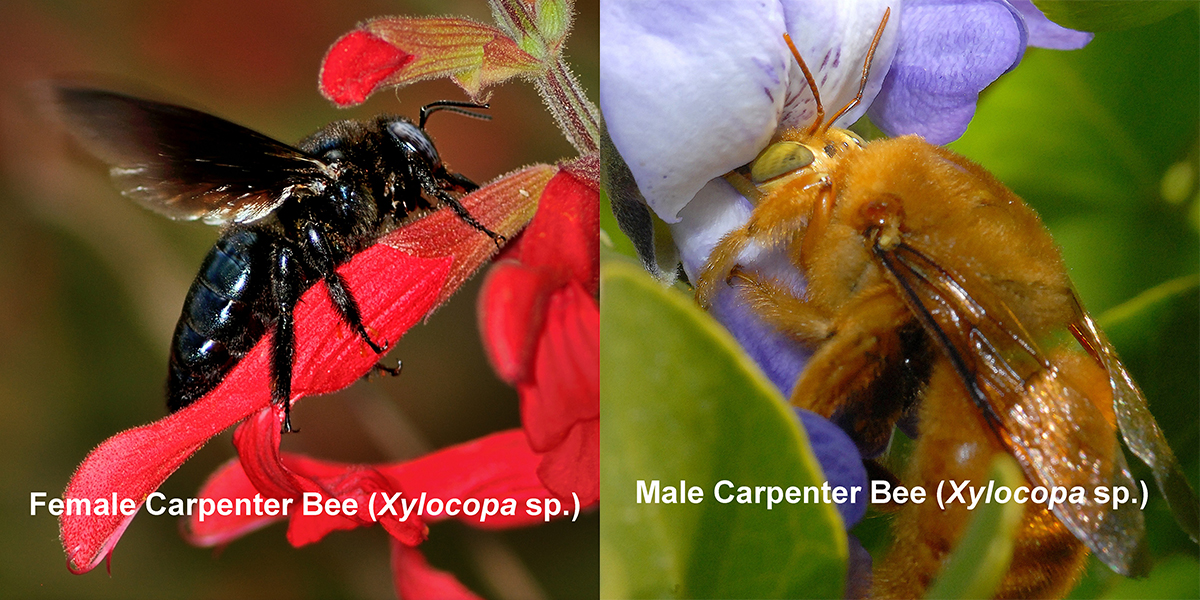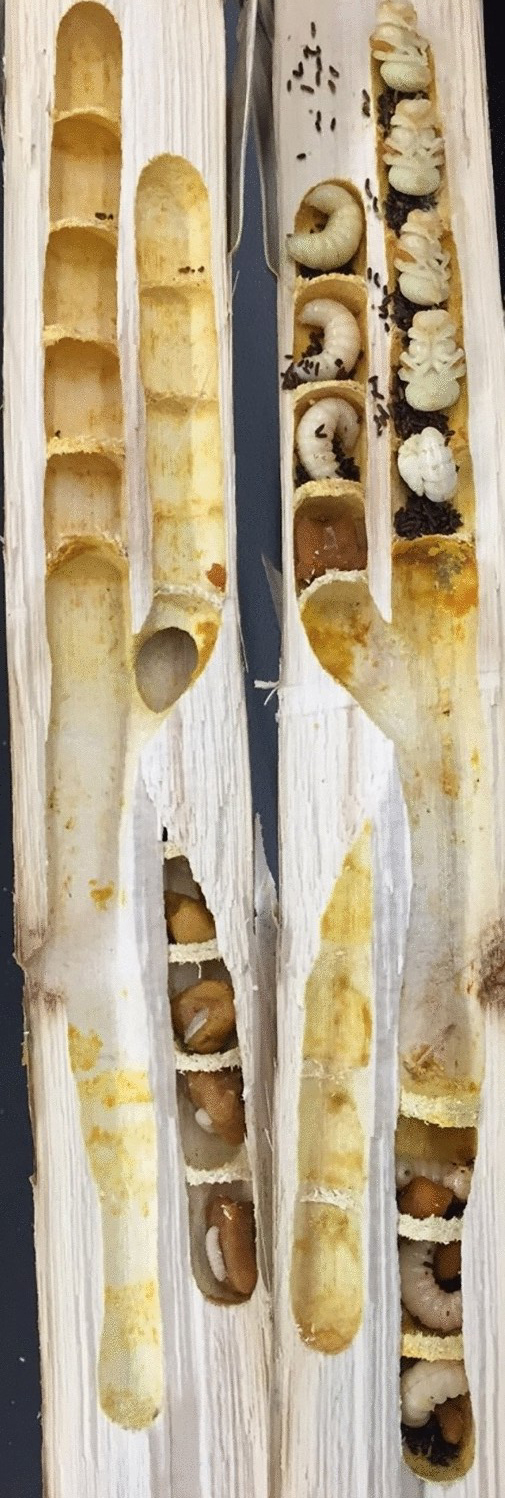Carpenter Bee

About
The Sonoran Desert is abuzz with bees. With about 1000 different species, this desert likely has more bee diversity than anywhere else in the world. Researchers and backyard bee enthusiasts alike are excited to discover more about our brilliant bees.
Carpenter bees are in the genus Xylocopa (xylo- meaning “of wood,” like in xylophone). There are many species of Xylocopa, but most are large, black bees that use their strong jaws to make their nests in wood (like little carpenters). In many species, the males are covered in yellow hair, giving them the nickname “teddy bear bees.”
Adaptations
Adult carpenter bees spend a lot of their time zipping from flower to flower in search of sugary nectar and protein-rich pollen for themselves and their larvae. In many plants pollen can be easily accessed for collection, but some plants hide their pollen away. When carpenter bees encounter a plant with hidden pollen, they will vibrate their bodies at certain frequencies on the flowers to release pollen — this is called floral sonication or “buzz pollination”. This allows the bees to collect pollen from more types of flowers and makes them especially useful pollinators of those plants. At an inch long, these big bees can’t fit into small tube-shaped flowers like other pollinators, but it doesn’t stop these tenacious insects! They simply bite a small opening at the base of the flower and slurp out the energy-rich nectar with their tongue. This behavioral adaptation is called nectar robbing.
The Sonoran Desert can be hot, but Sonoran carpenter bees have a special form of thermoregulation. They’re shaped in a way that allows them to transfer the heat in their body to their heads and abdomens, and then release it into the air as they zoom around. This allows them to keep flying even when it is over 100 degrees Fahrenheit (over 40 degrees Celsius), temperatures that would overheat most insects.
Food Web
Carpenter bees use their mandibles to chew through wood, but they don’t eat it. They use it to build the sawdust walls of their nests. Like most bees, Xylocopa adults are nectivorous pollinators, moving pollen between flowers as they visit for a snack. Pollination helps flowers turn into fruits — a food source that is important to humans and to a wide variety of living things.
Xylocopa themselves are also an important source of food for other organisms. Birds often catch carpenter bees (especially woodpeckers who drill into bee nests to eat the young). These bees are much too big and fast for most arthropods to catch, but they are occasionally eaten by large spiders or mantises. Other arthropods like mites, wasps, and flies parasitize carpenter bees and their larvae.

Habitat and Range
There are about 500 species of carpenter bees. They can be found everywhere on Earth except at sea, at the tops of the tallest peaks, and in Antarctica.
Sonoran carpenter bees are especially creative with where they nest since there is less wood in the Sonoran Desert. Some use agave or yucca stalks, and some use unpainted, untreated wood in human-made structures.

Family Life
When it comes time to settle down and start a family, carpenter bee housing looks a little different than the crowded hives most people associate with bees. Carpenter bees prefer hardwood floors and space to themselves. They often pick spots with other carpenter bee nests as neighbors, but they aren’t social. When a female is ready to lay eggs, she finds a nice bit of exposed wood and chews a tunnel. Inside this tunnel, each egg gets its own room separated by walls of bee-made sawdust. Each tube will hold several rooms, one after another in a line. Although these bees typically build their tube-shaped nests solo, some daughters may stay home and help their mother raise a new brood by cleaning and protecting the nest.
Males will also occasionally stick around to intimidate anything that comes too close to the entrance. Some generations of bees may return to the same nest site and change the shape of the nest as they expand it over the years. No matter what the nest looks like, each room gets a loaf of bee bread (a mix of nectar and pollen) and a single egg before being sealed with sawdust.
The eggs hatch within a week and spend the next six weeks eating the bee loaf and developing from a larva to a pupa and finally into their adult form. While males die shortly after their spring mating season, females can live up to three years, especially if helped by their daughters.
Glossary
- Genus:
- The next taxonomic rank/group up from species, followed by family.
- Nectar robbing:
- Drinking nectar from flowers without pollinating them.
- Floral sonication:
- Vibrations that trigger the release of pollen from flowers. Some flowers require this to release their pollen.
- Thermoregulation:
- The ability of an organism to control its own internal temperature.
- Nectivorous:
- Having a diet that consists mainly of nectar.
- Mandibles:
- Insects’ cutting/chewing mouthparts, like jaws.
- Parasitize:
- To infest, exploit, or live off of.
- Brood:
- A group of young that hatch at the same time.
Fun Facts
- Xylocopa sonorina, a species common in the Sonoran Desert, is also found in Hawaii. It’s unclear how they got there, but humans are thought to have transported them sometime before the 1870s.
- Many Xylocopa bees have a compartment called an acarinarium on their abdomens that houses beneficial mites. These mites live on the bee and in the nest, eating parasites.
- Only the female carpenter bees can sting (this is true for all ants, wasps, and bees). That said, male carpenter bees will pretend to be able to sting while defending a nest.
- Carpenter bees lay the largest eggs of any insect at about one centimeter long.
- Just after finishing their bee loaf and just before transitioning from a larva to a pupa, the baby bees take one giant poop, the first poop of their lives.
Conservation
Carpenter bees are not considered endangered, but insect populations have dramatically declined in recent years. This “Insect Apocalypse” is a result of stressors like habitat loss, overuse of pesticides, and light pollution.
To help carpenter bee populations, you can provide them with nesting sites. Keep dead tree stumps, flower stalks, etc., in your yard for natural nesting sites or make bee houses. See instructions on how to make one here. When constructing bee houses, replaceable or cleanable parts are ideal to help prevent the growth or spread of potentially harmful bacteria, fungi, viruses, and parasites.
At The Museum
- You can spot wild carpenter bees throughout the Museum. They especially enjoy foraging from flowers like yellow bells (which they nectar-rob) or trees like palo verde and mesquite.
- The Museum’s Bee Garden has carpenter bee houses. Drop by to check them out and learn how to make your own. You might even find Museum personnel talking about bees as you explore.










